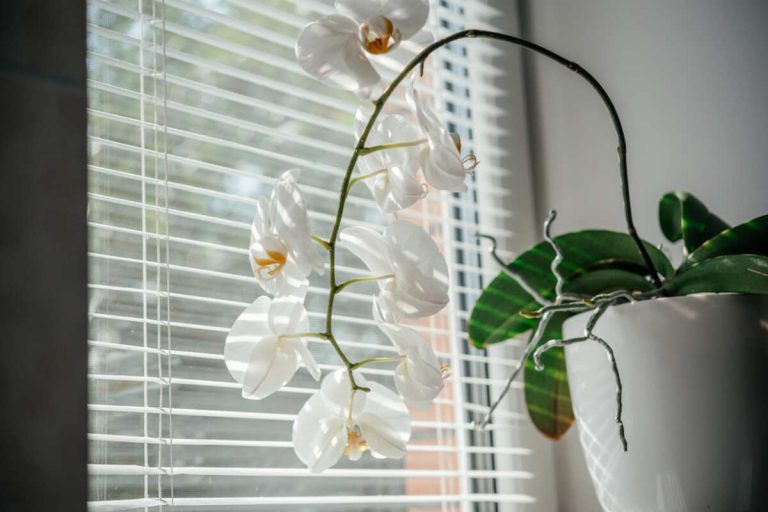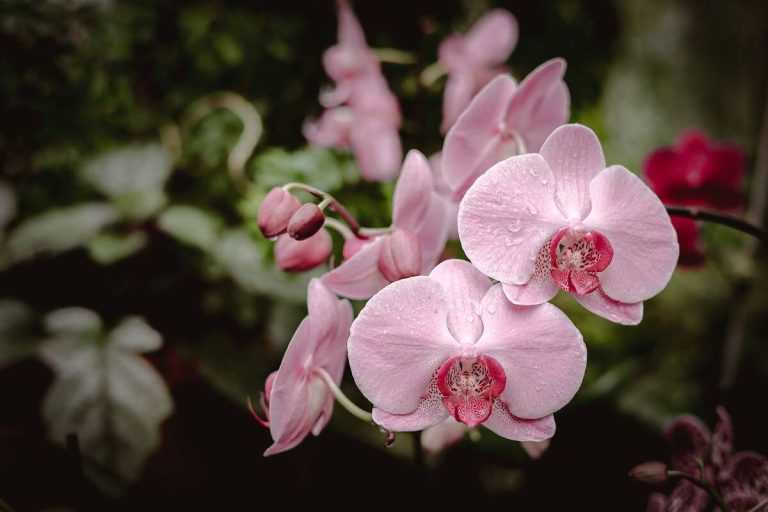Are Orchids Poisonous: How To Identify These Harmful Plants

Orchids are among the most diverse and beautiful plants in the world, but some of them can also be dangerous to humans and animals. In this article, we will explore how to identify orchids that are poisonous, what are the symptoms of orchid poisoning. Whether you are a beginner or an expert orchid lover, this article will help you enjoy these fascinating flowers without risking your health or the environment.
Dispelling Myths About Orchid Toxicity
Orchids are not all poisonous, and some are perfectly safe to have in homes with kids and pets. These flowering plants are among the most popular and admired ones, because they captivate gardeners, flower enthusiasts, and interior designers with their complex and exquisite flowers, which come in many colours and shapes. Orchids have a unique beauty that often symbolizes love, prosperity, and elegance. They are suitable for both indoor and outdoor growing, and there are many varieties and hybrids of orchids to choose from, each with its own appeal and charm.

Whether displayed as potted plants on windowsills, featured in elegant floral arrangements, or cultivated in specialized orchid gardens, these exquisite blooms have become a staple in the horticultural world, captivating the imagination of plant enthusiasts for centuries. Amidst the admiration and allure of orchids, a critical concern arises for pet owners and families with curious children. Many people wonder whether these captivating flowers are safe to have around their pets and young ones. Given that some plants can be harmful to consume, it is appropriate and significant to ask about the toxicity of orchids.
Due to the popularity of keeping orchids in gardens and homes, it is important for pet owners and families to be informed of any potential risks connected to these plants. Unintentional repercussions and pet-related problems may result from ignorance of the toxicity of particular orchid species. This blog’s main objective is to debunk rumours and false information about orchid toxicity. Although it’s a widespread misunderstanding, not all members of the Orchidaceae family are poisonous.
We will examine orchid toxicity in this blog and offer precise, thorough details on which orchids are safe to have around children, pets, and other family members. By understanding the specific varieties that are non-toxic and those that should be handled with caution, readers can confidently enjoy the beauty of these blooms without worrying about potential health risks.
Explaining the concept of toxicity levels in plants
The extent of adverse effects that the plant can cause when in contact with or consumed by humans or other animals depends on their toxicity level. Some plants may be fatally harmful and have constituents that can cause skin irritation and digestive distress. It is crucial to understand the toxicity level of plants, particularly orchids, to ensure everyone’s safety, especially in homes with small children and pets.
Common Orchid Varieties And Their Potential Toxicity
For their ornamental value and aesthetic appeal, many species of orchids can be grown. The most well-known and typical ones to have in your yard or home are:
- Phalaenopsis orchids (Phalaenopsis species): Due to their magnificent, arching flower spikes and spectrum of hues, they are the most well-known species of orchids. They are widely cultivated as indoor plants and are normally regarded as secure for both people and animals, though they may develop root rot if overfertilized.
- Cattleya Orchids (Cattleya spp.): These orchids are large, showy flowering with beautiful colours and are well known for their superb perfume. Although they are typically not regarded as extremely harmful, their lip or the central petal can occasionally cause minor skin irritations if handled.
- Dendrobium orchids (Dendrobium spp.): This species is known for its hardiness, is generally non-toxic to humans/animals and comes in a range of flower sizes. However, over-fertilizing can cause the leaves to yellow.
- Oncidium Orchids (Oncidium spp.): These orchids are considered less dangerous to humans and animals than other species and are usually admired for their clusters of tiny, delicate flowers.
- Miltoniopsis Orchids (Miltoniopsis spp.): They resemble pansy petals, and these orchids are commonly non-toxic, though they may develop brown spots if overfertilized. To avoid overfertilizing, you should only fertilize Miltoniopsis orchids every 4-6 weeks during the growing season.
- Phragmipedium orchids (Phragmipedium spp.): These plants have unusual blossoms that resemble slippers. Despite the fact that the plants are generally not seen as being particularly dangerous, some people who handle them may have mild skin irritation.
The belief that all orchids are extremely dangerous or lethal is likely driven by the fact that some Orchidaceae family members do possess toxic compounds. The majority of well-known and commonly cultivated orchid species pose no significant risk to humans or other animals and are found in homes and gardens. While some orchids may cause minor skin irritation or allergic reactions in people with sensitive skin, severe poisoning or potentially fatal effects from common decorative orchids are uncommon.
Clarification on orchids’ toxic and non-toxic varieties
Understanding the difference between hazardous and non-toxic orchid kinds is critical for maintaining the safety of households with pets and small children. By being informed about the specific varieties and understanding their potential effects, orchid enthusiasts can enjoy these exquisite flowers without unnecessary concern for their safety.
Comparing orchids’ toxicity with other common household plants
When compared to other common home plants, several popular orchid types are considered to have moderate toxicity levels. Some typical houseplants, on the other hand, such as ferns, lilies, and philodendron species, can be harmful to children and animals if consumed. Consumption of these plants may cause serious reactions that demand rapid medical intervention.

How to recognise potentially toxic orchids
Recognising potentially toxic orchids is essential for the safety of individuals, especially households with curious pets and young children. While working with exotic or wild orchid species, it is crucial to exercise caution, even though the majority of common orchid species are non-toxic. The following advice can assist you in identifying potentially hazardous orchids:
- Research and Consultation: Before acquiring any new orchid species, conduct thorough research to determine its toxicity status. Consult reputable sources, such as botanical gardens, horticultural societies, or experienced orchid growers, for accurate information about the plant’s potential hazards.
- Unfamiliar Characteristics: Be cautious of orchids with unfamiliar characteristics, especially if you are unsure of their identity. Some toxic orchids may have specific visual cues, such as brightly coloured markings or unusual growth patterns. If in doubt, refrain from handling or consuming the plant until its identity and toxicity are confirmed.
- Warning Labels: Some orchids, especially those sold as novelty items or exotic species, may come with warning labels indicating potential toxicity. Take these labels seriously and exercise caution when handling such plants.
The Myths About Orchids’ Toxicity To Humans
There is a widespread myth that all orchids are extremely harmful to people, which can cause unwarranted anxiety or caution when engaging with these lovely plants. It is crucial to realise that, when handled with standard precautions, the majority of popular orchid types, including Phalaenopsis, Cattleya, Dendrobiums, and Oncidiums, are typically safe and non-toxic, with the exception of edible flowers.
However, significant toxicity or potentially fatal effects from common decorative orchids are relatively rare. Some orchids may contain mild irritants in their tissues that can induce skin reactions in susceptible people. It is crucial to rely on credible sources and scientific evidence when discussing the potential dangers of interacting with orchids to avoid unnecessary alarm.
Explicitly describing how allergies and sensitivities are affected by orchids
Orchids should be handled with care because some people have acquired allergies or other sensitivities to them. Nasal congestion, sneezing, a runny nose, and itchy or watery eyes can all be symptoms of orchid pollen allergies. If you have a history of plant allergies, avoid orchids during their flowering season or choose a pollen-free species.
Before integrating orchids into your living space, consult with a healthcare practitioner if you have severe allergies or asthma caused by plant pollen. Taking these precautions can help reduce any potential negative health impacts. If necessary, you can choose hypoallergenic plants or seek alternatives to orchids to minimise any adverse effects on your health. By dispelling myths, promoting safe handling practises, and being mindful of individual sensitivities, we can foster a positive and enjoyable experience when interacting with these mesmerising blooms. Orchids can continue to be a source of joy and beauty in our lives without undue worry, enriching our homes and gardens with their elegant presence.
Addressing Concerns About Orchid Toxicity To Cats And Dogs
Pet owners often have concerns about the safety of having orchids in their homes, especially when they have curious cats or dogs. Numerous common orchid kinds are not very hazardous to pets, despite the fact that some orchids may contain minor irritants or poisons.
- Non-Toxic Orchids: Many popularly cultivated orchids, including Phalaenopsis, Cattleya, Dendrobiums, and Oncidiums, are thought to be safe for cats and dogs to handle. If consumed or accidentally come into contact, these orchids pose minimal to no risk.
- Use caution with unfamiliar varieties: Until their level of toxicity is understood, use caution and keep any less common or wild orchid species in your collection out of reach of animals. When working with strange plants, it is best to be cautious.
- Behavioural Concerns: Animals may be drawn to the scent or feel of orchids, although it is uncommon for them to eat a lot of them. To protect their safety, it is, however, always advisable to keep an eye on their interactions with plants.
Many popular orchids are safe for pets, but it is essential to be cautious with less familiar varieties and monitor your pet’s behaviour around plants. Veterinary experts can provide valuable advice to address any specific concerns, ensuring that both your orchids and your furry friends coexist harmoniously in your home.

Conclusion
Ultimately, the key to enjoying the beauty of orchids while maintaining a safe environment lies in responsible orchid cultivation and handling practises. By being informed, cautious, and proactive, pet owners and families can cultivate a thriving orchid collection without compromising the well-being of their loved ones. Let us embrace the enchanting world of orchids with both admiration and awareness. By combining our fascination for these exquisite plants with a commitment to safety and responsible care, we can create a beautiful and harmonious living space where orchids and loved ones flourish side by side.
FAQs









